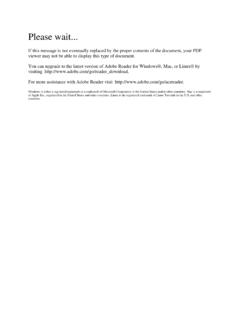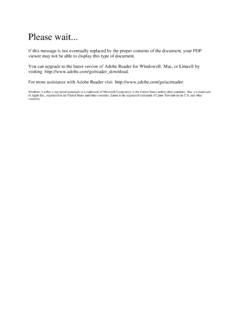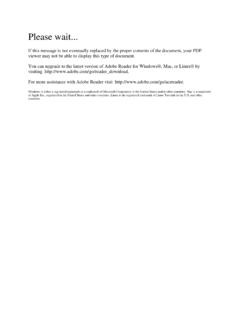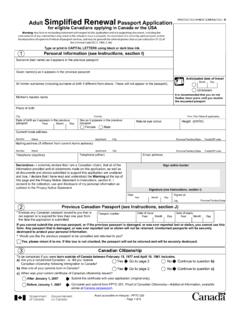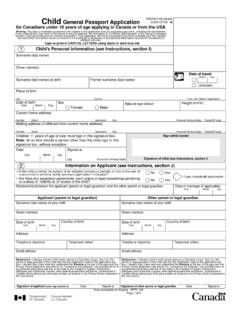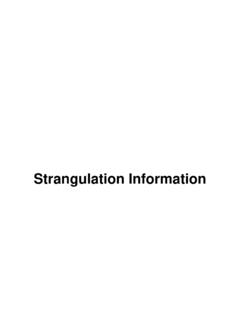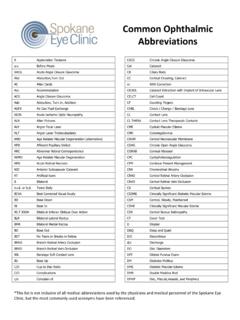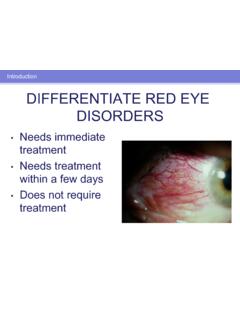Transcription of CHapter 1 – pediatriC HealtH assessment
1 pediatriC Clinical Practice Guidelines for Nurses in Primary Care2010 CHapter 1 pediatriC HealtH assessmentFirst Nations and Inuit HealtH Branch (FNIHB) pediatriC Clinical Practice Guidelines for Nurses in Primary Care. The content of this CHapter has been reviewed July of 9 pediatriC Clinical Practice Guidelines for Nurses in Primary 21 pediatriC Clinical Practice Guidelines for Nurses in Primary Care2010 pediatriC HealtH assessment 1 1 Healthy children should have regular HealtH maintenance visits, often done at well-baby clinics. Such visits customarily occur at 1 and 2 weeks of age, at 1, 2, 4, 6, 9, 12 and 18 months of age, and subsequently at 1- or 2-year intervals.
2 At each visit, the child should undergo an appropriate history, physical examination and developmental assessment . Immunizations should also be given according to provincial guidelines. Anticipatory guidance should be provided about the following topics: Appropriate nutrition Safety measures (see pediatriC Prevention Activities in the CHapter pediatriC Prevention Activities and HealtH Maintenance ) Expected developmental and behavioural eventsIn addition, an assessment should be made of the quality of physical care, nurturing and stimulation that the child is most important components that should be assessed at each HealtH maintenance visit are shown in Table clinical assessment of infants and children differs in many ways from that for adults.
3 Because children are growing and developing both physically and mentally, values for parameters such as dietary requirements and prevalence of disease, expected normal laboratory values and responses to drug therapy will be different from those observed in more information on adolescent HealtH assessment , see the CHapter Adolescent HealtH . introduCtionHealtH maintenanCe requirementsPediatric Clinical Practice Guidelines for Nurses in Primary Care2010 pediatriC HealtH Assessment1 2table 1 Components of Well-Child assessments at Various agesHealth parametermost important ages for assessmentHeight,. ,. ,. ,. ,. ( ,. ). ;. ,. * >. :. ,.4,.6,. * ( ,. ,.physician,.psychologist). Rourke Baby Record (RBR), revised May 2009, is an evidence-based HealtH supervision guide for primary HealtH care practitioners of children in the first 5 years of life.
4 The forms are available from the Rourke Baby Record web site ( ). Rourke Baby Record 2009: Evidence-based infant/child HealtH maintenance guides I IV (birth to 5 years) and immunization recordThe Greig HealtH Record is an evidence-based child and adolescent HealtH promotion guide for primary HealtH care practitioners caring for children aged 6 to 17 years (see Greig HealtH Record at ). pediatriC Clinical Practice Guidelines for Nurses in Primary Care2010 pediatriC HealtH assessment 1 3tips and teCHniquesCHildrenChildren who can communicate verbally should be included as historians, with additional details provided as necessary by parents or caregivers. HealtH care professionals should interact (for example, smile, coo) or play with children so as to not scare them or make them cry.
5 Questions, explanations and discussions occurring with children present should take into account their level of understanding. Young children may be assisted in providing details of the history by such techniques as having them play roles or draw pictures. The interviewer should gain an understanding of the child s terminology for various body should be granted privacy and confidentiality. Interview the adolescent alone Discuss with parents or caregiver separately, with the adolescent s permissionSee also the CHapter , Adolescent HealtH for more of tHe pediatriC History3 The pediatriC history includes many of the same components as the adult history, including: Identifying data Chief complaint History of present illness History of past illnesses Allergies Medication history Tobacco, alcohol and/or drug use Family history Personal and social history (including grade level, family of origin, interests, lifestyle) Review of systemsIn addition, the pediatriC history should include the following information.
6 Who the primary caregiver is Who is providing the history Pregnancy and perinatal history Birth history, including Apgar score Immunization history Detailed dietary history for the first year of life, including history of vitamin supplements and fluoride use. Also include dietary intake for other age groups, including how much tea, carbonated beverages and juice are being consumed Developmental history (including physical, cognitive, language, social and emotional) Social history, including questions about how many people live in the home, recent separations, deaths, family crises, friends, peer relationships, daycare arrangements, progress in school, smoking in the home and secure food access for child and family Physical environment at home, including presence of mold and poor heating or insulationpediatriC HistoryPediatric Clinical Practice Guidelines for Nurses in Primary Care2010 pediatriC HealtH Assessment1 4 Observe the entire infant at the beginning of the examination, before the assessment of specific organ systems.
7 It is important that the infant be completely undressed and in a warm environment with adequate appearanCeAssess the following: Level of consciousness, alertness, general behaviour and appearance (how well the baby looks) Symmetry of body proportions Posture of limbs (flexed, extended) Body movements (for example, arms and legs, facial grimace) State of nutrition and hydration Colour Any sign of clinical distress (for example, respiratory distress includes dyspnea, pallor, cyanosis, irritability)Vital siGnsAverage values of vital signs for newborns: Temperature C to C Heart rate 120 160 beats/minute Respiratory rate 30 60/minute, up to 80/minute if infant is crying or stimulated Systolic blood pressure 50 70 mm HgGroWtH measurementsMeasure and record length, weight and head circumference.
8 If the infant appears premature or is unusually large or small, assess gestational age (see Table 3, assessment of Gestational Age ). Average length at birth 50 52 cm Average weight at birth 3500 4400 g Average head circumference at birth 33 35 cm (this is done only at well-child visits unless hydrocephalus is suspected)These parameters should be recorded on gender-appropriate growth curves, which should form part of the child s HealtH record. Printable electronic versions of the growth charts are available at: Growth charts for boys: Birth to 36 months, and 2 to 20 years ( ) Growth charts for girls: Birth to 36 months, and 2 to 20 years ( ) For additional information about growth measurements, see Growth Measurement in the CHapter , pediatriC Prevention Activities and HealtH Maintenance.
9 SkinColour Pallor associated with low hemoglobin or vasoconstriction (for example, in shock) Cyanosis associated with hypoxemia Plethora associated with polycythemia or vasodilation Cherry red face associated with carbon monoxide poisoning Jaundice associated with elevated bilirubinlesions Milia: Pinpoint white papules of keratogenous material, usually on nose, cheeks and forehead, which last several weeks and then spontaneously resolve Miliaria: Obstructed eccrine (sweat) ducts appearing as pinpoint vesicles on forehead, scalp and skin folds; usually clear within 1 week Transient neonatal pustular melanosis: Small vesicopustules, generally present at birth, containing white blood cells (WBCs) and no organisms; intact vesicle ruptures to reveal a pigmented macule surrounded by a thin skin ring; spontaneously resolves by 3 months of age Erythema toxicum: Most common newborn rash, consisting of variable, irregular macular patches and lasting a few dayspHysiCal examination of tHe neWbornPediatric Clinical Practice Guidelines for Nurses in Primary Care2010 pediatriC HealtH assessment 1 5 Stork bite: Pink and flat nevus simplex, usually on face or back of the neck.
10 Those on face usually disappear by 18 months4 Caf au lait spots: Irregular brown, flat macules. Suspect neurofibromatosis if there are many (more than 5 or 6) large spots Mongolian spots: dark bluish/purplish patches present at birth, usually on back and buttocks but may be on limbs; common in First Nation s and Inuit children; usually fade away in first year of lifeHead and neCkHeadCheck for: Overriding sutures Anterior and posterior fontanelles (size, consistency, bulging or sunken) Abnormal shape of head (for example, caput succedaneum, molding, cephalohematomas, encephaloceles, microcephaly) Bruising of head, behind the ears or periorbitallyMeasure head : inspeCtion Check cornea for cloudiness (sign of congenital cataracts) Check conjunctiva for erythema, exudate, orbital edema, subconjunctival hemorrhage , jaundice of sclera Check for pupillary size, shape, equality and reactivity to light (PERRL: pupils equal, round, reactive to light), accommodation normal Red reflex.
